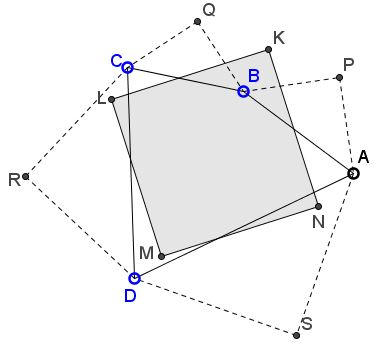Square out of a Quadrilateral
Here is problem 11328 (proposed by Dmitris Vartziotis) from the American Mathematical Monthly, 114 (December 2007):
Let ABCD be a convex quadrilateral. Let P be the point outside ABCD such that angle APB is a right angle and P is equidistant from A and B. Let points Q, R, and S be given by the same conditions with respect to the other three edges of ABCD. Let J, K, L, and M be the midpoints of PQ, QR, RS, and SP, respectively. Prove that JKLM is a square.
Putting it a little differently, let ABP, BCQ, CDR, and DAS be right isosceles triangles, with right angles at P, Q, R, S. Let J, K, L, and M be the midpoints of PQ, QR, RS, and SP, respectively. Prove that JKLM is a square.
|Activities| |Contact| |Front page| |Contents| |Geometry|
Copyright © 1996-2018 Alexander Bogomolny
Square out of a Quadrilateral
Let ABP, BCQ, CDR, and DAS be right isosceles triangles, with right angles at P, Q, R, S. Let J, K, L, and M be the midpoints of PQ, QR, RS, and SP, respectively. Prove that JKLM is a square.
I shall refer to the diagram below:

By van Obel's theorem, the diagonals PR and QS are equal and perpendicular. Lines KL, LM, MN, NK are the midlines,midlines,altitudes,medians,angle bisectors of triangles PQR, QRS, RSP, SPQ, so that
Note
A theorem by Jesse Douglas shows that the order of the two operations: 1) forming right isosceles triangles and 2) taking the midpoints, is not important. A square pops up regardless of the order in which the operations are performed. This also follows from the results of Varignon and Thébault.
|Activities| |Contact| |Front page| |Contents| |Geometry|
Copyright © 1996-2018 Alexander Bogomolny
73578733
